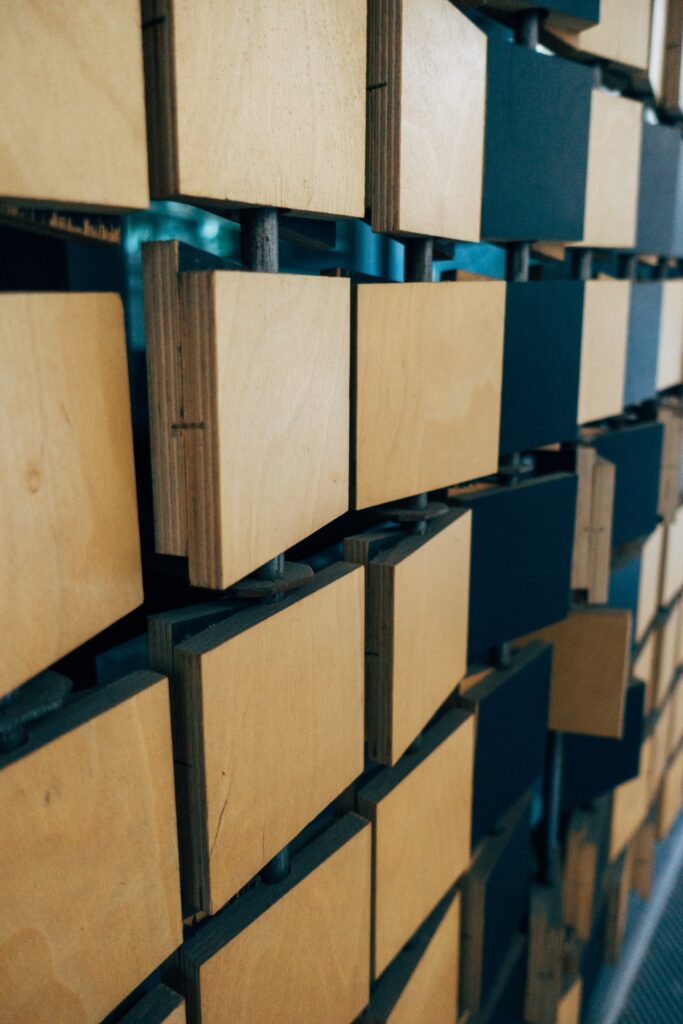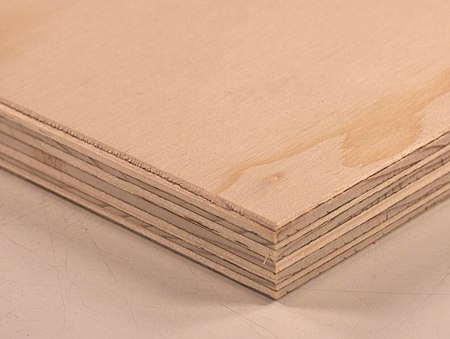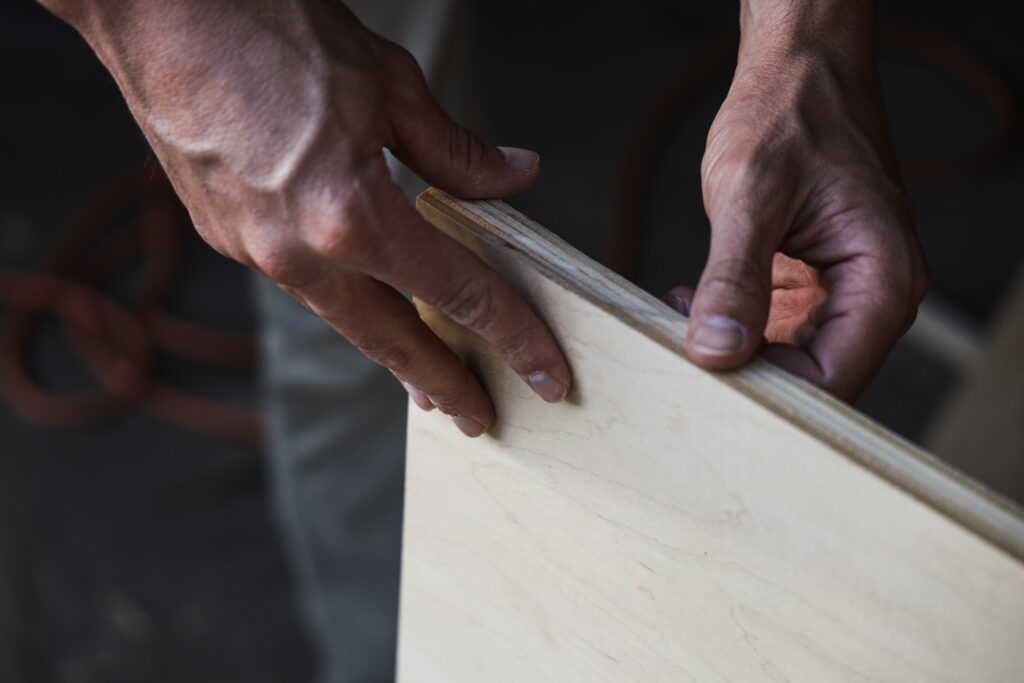Packaging
Plywood
plywood
Introduction
Plywood is a type of manufactured wood panel. It consists of three or more thin layers of wood bonded together with an adhesive. Each layer of wood, or ply, is usually oriented with its grain running at right angles to the adjacent layer in order to reduce the shrinkage and improve the strength of the finished piece. All plies may have the same thickness, or the panel may have thick and thin layers arranged in alternating fashion. The most common size is 1/2-inch thick by 4 feet wide by 8 feet long (1.3 cm thick by 122 cm wide by 244 cm long) sheets of plywood. However, other sized sheets are available ranging from 1/8 inch (3 mm) to 3/4 inch (19 mm) thicknesses.”
Section: Plywood has many uses
Section: It can be used for concrete forming in construction projects
Takeaway: Applications for interior finish work include wall paneling wainscoting ceiling tiles cabinet doors as well as furniture and shelving items”

Plywood is a type of manufactured wood panel.
Plywood is a type of manufactured wood panel that’s made from thin layers of wood glued together. It comes in various sizes and thicknesses, but the most common form is 1/8 inch thick. Plywood is lightweight and easy to work with, making it ideal for a variety of construction projects.
In addition to its use as an inexpensive building material, plywood also has many other applications:
- Plywood can be used for furniture and cabinetry.
- Plywood can be used for flooring and subfloors.
- Plywood can be used in packaging or as a pallet base when shipping goods throughout the world
It consists of three or more thin layers of wood bonded together with an adhesive.
Plywood consists of three or more thin layers of wood bonded together with an adhesive. It is manufactured by layering sheets of wood veneer and bonding them under heat and pressure with durable, moisture-resistant adhesives. It is widely used for both structural and non-structural applications, such as electrical panels, flooring, roofing, walls/ceilings (exterior or interior), furniture, cabinets and shelving.
Plywood is a manufactured wood product composed of multiple layers of thin sheets glued to each other. The glue used to bind these layers is referred to as phenol formaldehyde resin (PF). The phenol formaldehyde resin crosslinks the lignin polymers in cell wall structures within the fibers and hardens them into a substance capable of resisting high loads when compressed in tension along their grain direction due to its strength characteristics similar to that found in solid timber products like lumber or sawn boards made from trees grown specifically for construction purposes rather than being just leftovers from logging operations where trees are cut down for commercial use such as pulp making factories then later discarded after being processed through various stages before finally becoming paper products like newspapers etcetera).

Each layer of wood, or ply, is usually oriented with its grain running at right angles to the adjacent layer in order to reduce the shrinkage and improve the strength of the finished piece.
Each layer of wood, or ply, is usually oriented with its grain running at right angles to the adjacent layer in order to reduce the shrinkage and improve the strength of the finished piece. This method is used in plywood manufacture as well as in architectural millwork applications such as doors and cabinets.
All plies may have the same thickness, or the panel may have thick and thin layers arranged in alternating fashion.
Plywood is typically made up of three or more layers, or plies. All plies may have the same thickness, or the panel may have thick and thin layers arranged in alternating fashion. A 4-ply plywood sheet has four plies—two thick ones and two thin ones; a 6-ply sheet has three thick plies separated by two thin ones; and so on. The thickness of plywood is usually 1/2 inch but can be smaller or larger depending on the application. Thickness is determined by the number of plies:
- 3-ply = 1/4 inch
- 4-ply = 1/2 inch (thickest)

The most common size is 1/2-inch thick by 4 feet wide by 8 feet long (1.3 cm thick by 122 cm wide by 244 cm long) sheets of plywood.
Plywood comes in a variety of sizes, but the most common size is 1/2-inch thick by 4 feet wide by 8 feet long (1.3 cm thick by 122 cm wide by 244 cm long) sheets of plywood. Other sizes include 3/4-inch, 5/8-inch, 7/16-inch and so on.
Single plies are usually used for paneling because they are less expensive than double plies and still provide adequate strength for many purposes. Double plies may be used in applications where more strength is needed such as floors or roof decks since they provide extra rigidity not found in single ply boards.
The thicknesses can vary from 1/16” through 4”+ depending on the grade specified (i.e., construction vs marine).
However, other sized sheets are available ranging from 1/8 inch (3 mm) to 3/4 inch (19 mm) thickness.
Plywood comes in a number of thicknesses, ranging from 1/8 inch (3 mm) to 3/4 inch (19 mm). The thicker the sheet of plywood, the stronger it will be. Thicker sheets of plywood are stronger than thinner ones. They can be used for more demanding applications because they have more strength and rigidity than their thinner counterparts.
Thickness is measured in millimetres; for example, a 1-inch thick sheet of plywood consists of three layers one-eighth inch thick each stacked together.
Plywood for flooring applications is often tongue and groove (T&G); This prevents one board from moving up or down relative to its neighbor, providing a solid-feeling floor when laid down.
Plywood for flooring applications is often tongue and groove (T&G); This prevents one board from moving up or down relative to its neighbor, providing a solid-feeling floor when laid down.
- T&G means that the grain of the wood is aligned in a way that prevents movement of one board relative to another. This is done by cutting grooves into the wood at regular intervals and aligning them so that they fit together like puzzle pieces. In plywood, it’s usually done on all sides; this allows for maximum strength in case you need your boards to bear weight or take impact over time.
Plywood has many uses.
Plywood has many uses. It can be used for flooring, wall panels and ceiling tiles. Plywood may also be used to make cabinet doors, furniture, shelving, pallet, wooden crate and packaging materials.
Plywood is a type of wood that has been glued together to create layers. It’s usually made from softwoods, such as pine or fir, but it can also be made from hardwoods such as birch or oak. There are many different types of plywood available today, including marine-grade plywood and exterior grade plywood.
The most common type of plywood is the standard construction grade, which is used in home construction. This type of plywood is made from softwoods and typically comes in sheets that measure 4 feet by 8 feet (1.2 meters by 2.4 meters). It’s not as strong or durable as other types of plywood but it’s still a good option for many projects around your home.
Plywood is a type of wood that has been glued together to create layers. It’s usually made from softwoods, such as pine or fir, but it can also be made from hardwoods such as birch or oak. There are many different types of plywood available today, including marine-grade plywood and exterior grade plywood.
It is often used for concrete forming in construction projects.
Plywood is often used for concrete forming in construction projects. Plywood holds nails well, making it a good choice for concrete forming.
Plywood works best with thin-set mortar, which is the most widely used type of mortar for laying tile in homes and businesses. The thin-set mortar has the consistency of peanut butter and can be applied with a trowel or similar tool around the sides of your plywood forms before you set them up in place on top of your subflooring or walls. You need to make sure that you don’t use too much thin-set mortar; otherwise, it will become hard as rock once it dries up and ruin any chance at getting smooth curves out of your plywood forms!
It uses include exterior wall sheathing, roof sheathing, subflooring and shingles.
Plywood is a material that can be used for many different applications. It is made of thin layers of wood glued together, and these layers are pressed into a single sheet. Plywood has many uses, including as exterior wall sheathing, roof sheathing, subflooring and shingles.
It’s also possible to use plywood to create frames for windows and doors; however, if you do so it’s important to make sure that the plywood will not warp or shrink when exposed to moisture from rain or snow.
Applications for interior finish work include wall paneling, wainscoting, ceiling tiles and cabinet doors as well as furniture and shelving items.
Plywood is used for interior finish work, including wall paneling, wainscoting and ceiling tiles. Plywood can also be turned into furniture or shelving items. The term plywood comes from the layers of wood that make up this product. You might have heard it referred to as a “three-ply” or “five-ply” product because it is made from three or five separate layers of wood glued together at right angles. Plywood has been used as an interior finish on walls and ceilings since its invention in the late 19th century by Charles Culp Darrah in Philadelphia, Pennsylvania. It was patented on October 24th 1901 by Darrah’s employer William H. Merrill; however his patent application was rejected due to an error he made in describing how it would be manufactured (he forgot to include information about how many plies were used).
Conclusion
Plywood is a great material to work with and can be used in a variety of applications. It is strong, versatile and easy to use. The fact that it is made from renewable resources makes it even more appealing as an option for people looking for sustainable building materials.
